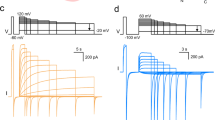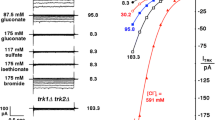Abstract
Tandem pore-loop potassium channels differ from the majority of K+ channels in that a single polypeptide chain carries two K+-specific segments (P) each sandwiched between two transmembrane helices (M) to form an MP1M–MP2M series. Two of these peptide molecules assemble to form one functional potassium channel, which is expected to have biaxial symmetry (commonly described as asymmetric) due to independent mutation in the two MPM units. The resulting intrinsic asymmetry is exaggerated in fungal 2P channels, especially in Tok1p of Saccharomyces, by the N-terminal presence of four more transmembrane helices. Functional implications of such structural asymmetry have been investigated via mutagenesis of residues (L290 in P1 and Y424 in P2) that are believed to provide the outermost ring of carbonyl oxygen atoms for coordination with potassium ions. Both complementary mutations (L290Y and Y424L) yield functional potassium channels having quasi-normal conductance when expressed in Saccharomyces itself, but the P1 mutation (only) accelerates channel opening about threefold in response to depolarizing voltage shifts. The more pronounced effect at P1 than at P2 appears paradoxical in relation to evolution, because a comparison of fungal Tok1p sequences (from 28 ascomycetes) shows the filter sequence of P2 (overwhelmingly TIGYGD) to be much stabler than that of P1 (mostly TIGLGD). Profound functional asymmetry is revealed by the fact that combining mutations (L290Y + Y424L)—which inverts the order of residues from the wild-type channel—reduces the expressed channel conductance by a large factor (20-fold, cf. <twofold for the single mutants).










Similar content being viewed by others
References
Bertl A, Slayman CL (1993) Complex modulation of cation channels in the tonoplast and plasma membrane of Saccharomyces cerevisiae: single-channel studies. J Exp Biol 172:271–287
Bertl A, Bihler H, Kettner C, Slayman CL (1998a) Electrophysiology in the eukaryotic model cell Saccharomyces cerevisiae. Pflügers Arch 436:999–1013
Bertl A, Bihler H, Reid JD, Scheurmann-Kettner C, Slayman CL (1998b) Physiological characterization of the yeast plasma-membrane outward rectifying K+ channel, DUK1 (TOK1) in situ. J Membr Biol 162:67–80
Bertl A, Ramos J, Ludwig J, Lichtenberg-Frate H, Reid JD, Bihler H, Calero F, Martinez P, Ljungdahl PO (2003) Characterization of potassium transport in wild-type and isogenic yeast strains carrying all combinations of trk1, trk2, and tok1 null mutations. Mol Microbiol 47:767–780
Bihler H, Slayman CL, Bertl A (2002) Low-affinity potassium uptake by Saccharomyces cerevisiae is mediated by NSC1, a calcium-blocked non-specific cation channel. Biochim Biophys Acta 1558:109–118
Chapman ML, Krovetz HS, VanDongen AMJ (2001) GYGD pore motifs in neighbouring potassium channel subunits interact to determine ion selectivity. J Physiol 530:21–33
Conway EJ, Breen J (1945) An ‘ammonia’-yeast and some of its properties. Biochem J 39:368–371
Cordero-Morales JF, Cuello LG, Zhao Y-X, Jogini V, Cortes DM, Roux B, Perozo E (2006) Molecular determinants of gating at the potassium-channel selectivity filter. Nature Str Mol Biol 13:311–318
Doyle DA, Morais-Cabral J, Pfuetzner RA, Kuo A, Gulbis JM, Cohen SL, Chait BT, MacKinnon R (1998) The structure of the potassium channel: molecular basis of K+ conduction and selectivity. Science 280:69–77
Durell SR, Guy HR (1999) Structural models of the KtrB, TrkH, and Trk1,2 symporters based on the structure of the KcsA channel. Biophys J 77:789–807
Durell SR, Hao Y, Guy HR (1998) Structural models of the transmembrane region of voltage-gated and other K+ channels in open, closed, and inactivated conformations. J Struc Biol 121:263–284
Durell SR, Shrivastava IH, Guy HR (2004) Models of the structure and voltage-gating mechanism of the Shaker K+ channel. Biophys J 87:2116–2130
Fairman C, Zhou X, Kung C (1999) Potassium uptake through the TOK1 K+ channel in the budding yeast. J Membr Biol 168:149–157
Gray AT, Winegar BD, Leonoudakis DJ, Forsayeth JR, Yost CS (1998) TOK1 is a volatile anesthetic stimulated K+ channel. Anesthesiology 88:1076–1084
Heginbotham L, Lu Z, Abramson T, MacKinnon R (1994) Mutations in the K+ channel signature sequence. Biophys J 66:1061–1067
Hill JE, Myers AM, Koerner TJ, Tzagoloff A (1986) Yeast/E. coli shuttle vectors with multiple unique restriction sites. Yeast 2:163–167
Jan LY, Jan YN (1997) Cloned potassium channels from eukaryotes and prokaryotes. Annu Rev Neurosci 20:91–123
Jiang Y-X, Lee A, Chen J-Y, Ruta V, Cadene M, Chait BT, MacKinnon R (2003) X-ray structure of a voltage-dependent K+ channel. Nature 423:33–41
Johansson I, Blatt MR (2006) Interactive domains between pore loops of the yeast K+ channel TOK1 associate with extracellular K+ sensitivity. Biochem J 393:645–655
Ketchum KA, Joiner WJ, Sellers AJ, Kaczmarek LK, Goldstein SAN (1995) A new family of outwardly rectifying potassium channel proteins with two pore domains in tandem. Nature 376:690–695
Ko CH, Gaber FR (1991) TRKI and TRK2 encode structurally related K+ transporters in Saccharomyces cerevisiae. Mol Cell Biol 11:4266–4273
Kuroda T, Bihler H, Bashi E, Slayman CL, Rivetta A (2004) Currents through the yeast TRK-potassium transporters, measured by patch-clamping, are dominated by chloride and depend upon strain background. J Membr Biol 198:177–192
Lesage F, Guillemare E, Fink M, Duprat F, Lazdunski M, Romey G, Barhanin J (1996) A pH-sensitive yeast outward rectifier K+ channel with two pore domains and novel gating properties. J Biol Chem 271:4183–4187
Lopes CM, Gallagher PG, Buck ME, Butler MH, Goldstein SA (2001) Block of Kcnk3 by protons. Evidence that 2-P-domain potassium channel subunits function as homodimers. J Biol Chem 276:24449–24452
Loukin SH, Vaillant B, Zhou X-L, Spalding EP, Kung C, Saimi Y (1997) Random mutagenesis reveals a region important for gating of the yeast K+ channel Ykc1. EMBO J 16:4817–4825
Miosga T, Witzel A, Zimmermann FK (1994) Sequence and function analysis of a 9.46 kb fragment of Saccharomyces cerevisiae chromosome X. Yeast 10:965–973
Morais-Cabral JH, Zhou Y-F, MacKinnon R (2001) Energetic optimization of ion conduction rate by the K+ selectivity filter. Nature 414:37–42
Reid JD, Lukas W, Shafaatian R, Bertl A, Scheurmann-Kettner C, Guy HR, North RA (1996) The S. cerevisiae outwardly-rectifying potassium channel (DUK1) identifies a new family of channels with duplicated pore domains. Recept Channels 4:51–62
Roberts SK (2003) TOK homologue in Neurospora crassa: first cloning and functional characterization of an ion channel in a filamentous fungus. Eukaryot Cell 2:181–90
Rodriguez-Navarro A, Ramos J (1984) Dual system for potassium transport in Saccharomyces cerevisiae. J Bacteriol 159:940–945
Roller A, Natura G, Bihler H, Slayman CL, Eing C, Bertl A (2005) In the yeast potassium channel, Tok1p, the external ring of aspartate residues modulates both gating and conductance. Pflügers Arch 451:362–370
Vergani P, Blatt MR (1999) Mutations in the yeast two-pore K+ channel YKC1 identify functional differences between the pore domains. FEBS Lett 458:285–291
Véry AA, Sentenac H (2002) Cation channels in the Arabidopsis plasma membrane. Trends Plant Sci 7:168–175
Yuill KH, Ashmole I, Stanfield PR (2004) The tandem-pore K+ channel TASK-1: mutations of GYG in P1 and GFG in P2 alter ionic selectivity. Biophys J 86(1):549A–549A
Zhou Y, Morais-Cabral JH, Kaufman A, MacKinnon R (2001) Chemistry of ion coordination and hydration revealed by a K+ channel-Fab complex at 2.0 Å resolution. Nature 414:43–48
Zhou M, MacKinnon R (2004) A mutant KcsA K+ channel with altered conduction properties and selectivity filter ion distribution. J Mol Biol 338:839–846
Zhou XL, Vaillant B, Loukin SH, Kung C, Saimi Y (1995) YKC1 encodes the depolarization-activated K+ channel in the plasma membrane of yeast. FEBS Lett 373:170–176
Acknowledgements
The authors are indebted to Drs. T. Miosga and P. Ljungdahl for yeast strains. The work was supported by Grants from the Deutsche Forschungsgemeinschaft (to A.B.) and from the US National Institutes of Health (GM-60696, to C.L.S.).
Author information
Authors and Affiliations
Corresponding author
Appendix
Appendix
Sequence alignments and dendrograms for the two MPM motifs in fungal 2P potassium channels are shown in Figs. 11 and 12, respectively. Sequences were obtained from the currently annotated fungal proteomes, and were first aligned pairwise with the Saccharomyces sequence, by means of the BLAST algorithm at National Center for Biotechnology Information (http://www.ncbi.nlm.nih.gov/blast/bl2seq/wblast2.cgi). Final alignment was guided by reckoning on highly conserved residues at the ends of several segments shown (Fig. 11) and refined by means of the Clustal algorithm. The six residues (L67) at the end of MPM1 and six more at the beginning of MPM2 belong to the long cytoplasmic loop which connects MPM1 and MPM2 in each species. Sequences marked with (*), in the legend, appear truncated on the N-terminus, to contain fewer than eight transmembrane helices. The final alignments, consensus sequences, and dendrograms were calculated by means of Lasergene software (DNASTAR, Inc., Madison, WI, USA), scaled according to inferred base changes.
MPM alignments. See text (above) for source and treatment of sequences. During the alignment process, probable missing residues (–) were replaced with “X” (any), which were formally treated as nonconserved. This was operationally equivalent to assigning an alignment bias to the segment ends. In the drawing, presumed functional segments of the molecule are artificially separated by vertical white bars. No homologue corresponding to Ac2 (Aspergillus clavatus (2)) was found in the genome–proteome database. Species key as follows: Mg = Magnaporthe grisea; Nf2 = Neosartorya fischeri (2)*; Gz = Gibberella zaea; An2 = Aspergillus niger (2); Nc = Neurospora crassa; At2 = Aspergillus terreus (2)*; Cglo = Chaetomium globosum; Ao2 = Aspergillus oryzae (2); Pn = Pheosphaeria nodorum; Af2 = Aspergillus fumigatus (2)*; Nf3 = Neosartorya fischeri (3); Yl1 = Yarrowia lipolytica (1); Ac3 = Aspergillus clavatus (3); Yl2 = Yarrowia lipolytica (2); Af3 = Aspergillus fumigatus (3); Ca = Candida albicans; Nf1 = Neosartorya fischeri (1); Cgla = Candida glabrata; An1 = Aspergillus niger (1); Le = Lodderomyces elongisporus; At1 = Aspergillus terreus (1); Kl = Kluyveromyces lactis; Ao1 = Aspergillus oryzae (1); Ps = Pichia stipitis; Af1 = Aspergillus fumigatus (1); Sc = Saccharomyces cerevisiae; Ac1 = Aspergillus clavatus (1); Pg = Pichia guilliermondii
MPM dendrograms. See text (above) and legend to Fig. 11 for method details. Despite the apparent faster accumulation of mutations in MPM1 than in MPM2, the major clustering of species and isoforms, as denoted by equivalent colors on the two dendrograms, is similar between MPM1 and MPM2
Of the total of 32 sequences now available, the 28 shown are all from ascomycete fungi; the other four were from basidiomycete fungi (Cryptococcus, Ustilago, and Coprinopsis), but two of those were only weakly homologous. Sequence conservation, judged by identity with the consensus sequence for each MPM unit and shown by the shading in Fig. 11, varies from ~35% (Pichia guilliermondii) to ~75% (Neosartorya fischeri (3)); conservative substitutions (similarity) increase these numbers by ~15%.
The dendrograms (Fig. 12) make clear that the two channel-forming regions, MPM1 and MPM2, have evolved quite differently from each other, with MPM1 accumulating nearly twice as many coding mutations from the apparent stem as MPM2. This is globally consistent with the simple comparison of filter sequences (see “Introduction”).
Rights and permissions
About this article
Cite this article
Roller, A., Natura, G., Bihler, H. et al. Functional consequences of leucine and tyrosine mutations in the dual pore motifs of the yeast K+ channel, Tok1p. Pflugers Arch - Eur J Physiol 456, 883–896 (2008). https://doi.org/10.1007/s00424-008-0446-0
Received:
Revised:
Accepted:
Published:
Issue Date:
DOI: https://doi.org/10.1007/s00424-008-0446-0






